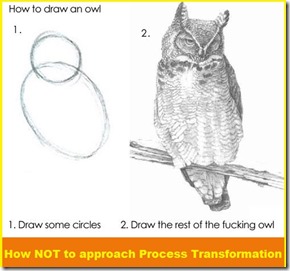When you set off on a process transformation initiative, it is intrinsically about where you want to go and how you want to be, how differently you want to do things – it is about to-be, the target state.
It is about the Future.
And you can get there only when you have a sense of acuity of that future. Because the more clearly you see your target, the better are your chances of hitting it.
But is it all only about the future?
The answer is a definite no. It need not, and should not be only about the destination. For, where you are when you begin, will decide the path and the journey to that future you have imagined. In other words, the starting point, or your current state actually does matter and so, it is all very much about the Present, too.
Great vision is nothing more than just a fancy dream – or wasted dollars, if you don’t meticulously connect the dots from the present to the future. You knew that, of course, but there is an important point there that I want to highlight. A point that I feel is often overlooked when these initiatives are being planned.
Transformation initiatives – especially those involving business technology like BPM, fail badly when you see the present and the future as just two dots that need to be connected by one line or a single path of execution. The reality that many initiatives fail to acknowledge, thereby seriously compromising their chances at true success from transformation, is that it is not just two dots and one path that’s involved. There are in fact many dots that need to be connected and therefore many paths connecting them.
What can guarantee, or at least considerably improve the chances that you turn your vision to reality is the ability to astutely decipher the number and position of all the dots and all those different paths that connect them. Those paths form the actual journey that will take you from the present to the future and help you pull off real transformational success.
What are my dots?
 So, figuring out the right path for your transformation journey would mean knowing how to spot those dots and then taking the path that connects all of them, right, but the nature and position of those dots to be connected are very unique to your organization, so it is important to know that it will take someone who understands your ecosystem pretty well to do the job.
So, figuring out the right path for your transformation journey would mean knowing how to spot those dots and then taking the path that connects all of them, right, but the nature and position of those dots to be connected are very unique to your organization, so it is important to know that it will take someone who understands your ecosystem pretty well to do the job.
But IMO, at a very basic level, regardless of what kind of organization you are, it is possible to say that the state you aspire for will be the path connecting dots that fall under three basic categories.
Keep the good, get rid of the bad
These are dots around discovering and preserving what you are doing right today while at the same time, discovering and fixing what you are doing ineffectively or downright wrong.
Firms tend to assume they are either doing everything right or everything wrong. The truth of course, is somewhere in between and it is important to discern the good from the not-so-good and the downright bad. What are those best operational practices that have evolved over years that have endeared customers? What are those areas where deep employee insight and creativity have made a difference – to cost, efficiency, customer experience or even something seemingly peripheral as enabling camaraderie among employees? What are those activities that are always delayed? What are those tasks that stress your users the most? What are those inefficiencies and that might have crept in to become restraints to better business performance?
Re-thinking, re-inventing, re-engineering
This set of dots will be a result of weaving together opportunities to rethink how you are doingwhat you are doing – to question, challenge, change and disrupt the status quo. This again isn’t some grand new idea, but certainly one that is most challenging to pull off. As is the nature of human beings, we tend to slip in to the comfort of familiar routines, habits and comforting known patters to perform our activities at work. Improving processes with transformation as a goal calls for breaking free of these chains. Obviously this has very little to do with technology and more about unlearning and re-thinking. Figure out how to get this done and your dots begin to appear more clearly and your chances at success dramatically improve.
Inertia, Change, and resistance
And finally dots that need to be connected to battle all the forces that distract, resist change and challenge you along the journey. The security of a comforting routine makes our work and personal life appear more manageable and we tend to feel better in control of things on both fronts. It is a natural reaction to resist any force that upsets that balance. Transformational programs involving business technology depend a lot on the collective positive energy, and buy-in from end-users to usher in change. Success comes from creating a collective sense of enthusiasm and individual level desire to seek improvement and eagerness to change and improve the style and quality of work. Again, not as easy as it seems, but getting this right would again mean astonishing outcomes.
There’s More than Meets the eye
Transformation initiatives usually  involve much more than you bargained for and success is not guaranteed by just the task of imagining a great vision and a future, but more from being able to understand your present state very very accurately so that you can chart out the best fit itinerary for that journey to the ‘future’ state that is visualized.
involve much more than you bargained for and success is not guaranteed by just the task of imagining a great vision and a future, but more from being able to understand your present state very very accurately so that you can chart out the best fit itinerary for that journey to the ‘future’ state that is visualized.
 involve much more than you bargained for and success is not guaranteed by just the task of imagining a great vision and a future, but more from being able to understand your present state very very accurately so that you can chart out the best fit itinerary for that journey to the ‘future’ state that is visualized.
involve much more than you bargained for and success is not guaranteed by just the task of imagining a great vision and a future, but more from being able to understand your present state very very accurately so that you can chart out the best fit itinerary for that journey to the ‘future’ state that is visualized.
Figure out the dots relevant to you and the chances of a great result are all yours for the taking. Think about it – with the kind of returns BPM initiatives done right have to offer, there really is not much that that can keep you from transformational success once you figure out the right approach and take it.











0 comments:
Post a Comment